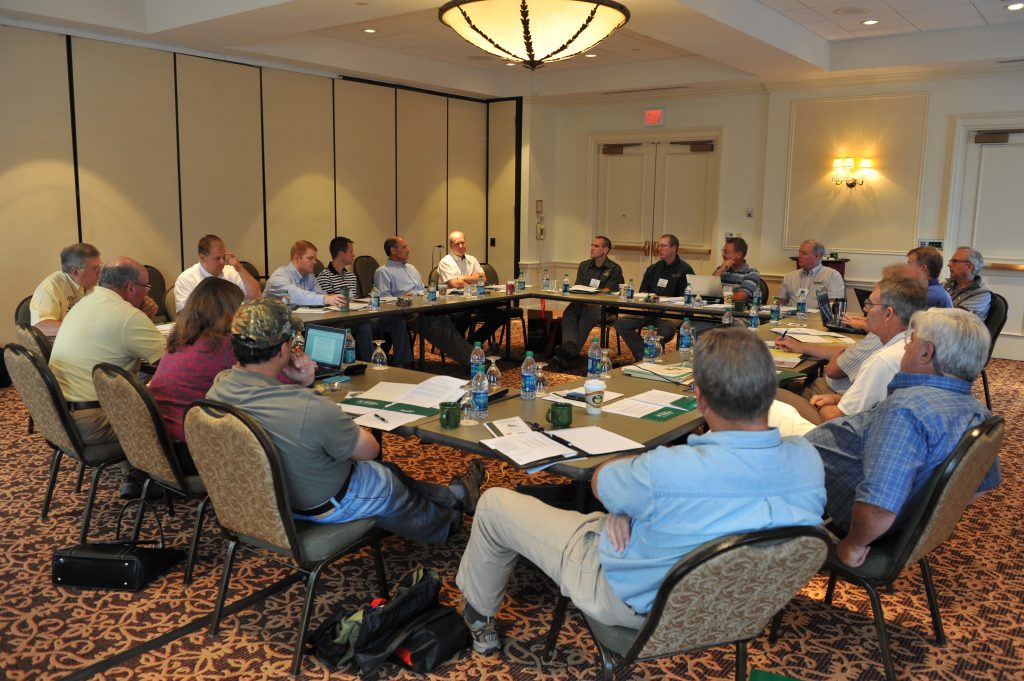
I am behind in my blogosphere. We’ve been very busy this summer preparing to host and then hosting the 19th annual meeting of the National Bobwhite Technical Committee. Soon after the meeting I was e-mailed a series of questions about it from well known outdoor writer and blogger Bill Cochran (Roanoke Times and World News – Roanoke VA). The biggest factor to note about the meeting is it was a huge team effort. Our crew came together and got it done. My answers to Bill’s questions I thought would serve as a good post this month. We will have a guest blogger in September – one of our Private Lands Wildlife Biologist, David Brian, will share a success story with you.
“Bill thanks for inquiring about the 19th Annual National Bobwhite Technical Committee meeting that VDGIF along with our many partners and sponsors hosted at Hotel Roanoke this past week. The meeting was a big success. The NBTC represents 25 states that have signed on in support of the National Bobwhite Conservation Initiative (NBCI). The NBCI is a comprehensive undertaking that results from efforts ongoing since 1995. This was Virginia’s second chance to host. We hosted back in 1997 at the 3rd annual meeting and we will not likely host again for 15 to 20 years. This gives every state a chance to host and spreads the financial burden, as well. On that note, our sportsmen and women need to know that 95% of the meeting is funded by registration fees and sponsorships, so our sportsmen are not footing the bill.”
How many people did the conference attract, and how does this compare to past years?
We had about 125 this year, and 23 of the 25 NBCI states were represented. This compares well to the past several years, and is especially good when state and federal travel budgets are somewhat reduced. The meeting revolves around a series of working sub-committees and it is our one chance to all meet face-to-face each year to continue to move quail conservation forward. You can accomplish a lot by phone, e-mail and Skype, but without at least one person-to-person meeting, we’d have a hard time operating across so many states.
What would you say was the most defining thing that occurred?
To me it was that so many different entities were represented. We reached out to many with a message that we needed to unite for early –succession species conservation. Our theme was Appalachian Overlap: Where the Ranges of Quail, Grouse, Woodcock, Turkey and Golden-winged Warblers Overlap. The US Forest Service, the National Wild Turkey Federation, Quail Forever, the Quail and Upland Wildlife Federation, The Ruffed Grouse Society, the Natural Resources Conservation Service, the Virginia Dept. of Forestry, the Appalachian Mountains Joint Venture, and many others were either in attendance or actually helping with the meeting. We all feel we need to unite around a central message that young forests, weeds, thickets, native grasslands and other habitats we deem early-succession habitats are just as important to wildlife and ecosystems as are wetlands and mature forests. We are kind of saying “let’s not focus on our differences, let’s focus on what we can agree on.”
Did participants appear to have enthusiasm that the job of restoring quail can be accomplished?
I think participants would be the first to tell you, yes they feel quail restoration can occur. It is occurring on modest levels in several areas. But I also think they’d tell you to roll up your sleeves for a long fight. We have talked before that deer, bear, turkey, geese, ducks – none of those species came back in 20 years, it was more like 75 years from the beginning to the end of their recoveries and quail will be no different. Yes – we have been working already for a number of years, but I’d argue that only in the last 10 to 15 years have the quail recovery efforts reached the national capacity to start to promote meaningful recovery. This is a motivated “glass half full” type of a group, though. Those that show up believe, those that don’t – they fell out years ago. I do not believe there is any quit in this group.
On a side note… On a side note, I’d ask folks to stop and wonder what could be done for quail if we had the entities behind us that waterfowl have behind them. Over 6 billion dollars have been spent collectively on waterfowl conservation in the last 75 years. The duck world has the North American Wetlands Conservation Act and the National Duck Stamp behind them, not to mention the US Fish and Wildlife Service and the National Wildlife Refuges System. This is largely due to the fact that ducks and geese migrate and quail and upland game birds do not – they fall under different jurisdictions. Hence for many years states have been left to function on their own, doing the best they can to face multiple challenges for many species. What NBTC / NBCI is trying to do is to provide a collaborative national umbrella for all states and non-governmental organizations to work together under. We are much more optimistic having an entity like NBCI.




